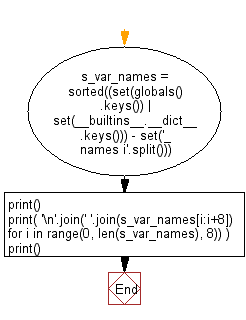Python: List the special variables used within the language
Python Basic: Exercise-97 with Solution
Write a Python program to list the special variables used within the language.
Sample Solution:-
Python Code:
s_var_names = sorted((set(globals().keys()) | set(__builtins__.__dict__.keys())) - set('_ names i'.split()))
print()
print( '\n'.join(' '.join(s_var_names[i:i+8]) for i in range(0, len(s_var_names), 8)) )
print()
Sample Output:
ArithmeticError AssertionError AttributeError BaseException BlockingIOError BrokenPipeError BufferError BytesW arning ChildProcessError ConnectionAbortedError ConnectionError ConnectionRefusedError ConnectionResetError Deprecati onWarning EOFError Ellipsis EnvironmentError Exception False FileExistsError FileNotFoundError FloatingPointError FutureWarning GeneratorE xit IOError ImportError ImportWarning IndentationError IndexError InterruptedError IsADirectoryError KeyError KeyboardInterrupt LookupError MemoryError NameError None NotADirectoryError NotImplemented NotImplementedError OSError OverflowError PendingDeprecationWarning PermissionError ProcessLookupError RecursionError ReferenceErr or ResourceWarning ---------- filter float format frozenset getattr globals hasattr hash help hex id input int isinstance issubclass iter len license list locals map max memoryview min next object oct open ord pow print property quit range repr reversed round set setattr slice sorted staticmethod str sum super tuple type vars zip
Flowchart:

Python Code Editor:
Have another way to solve this solution? Contribute your code (and comments) through Disqus.
Previous: Write a Python program to print the current call stack.
Next: Write a Python program to get the system time.
What is the difficulty level of this exercise?
Test your Programming skills with w3resource's quiz.
Python: Tips of the Day
Find current directory and file's directory:
To get the full path to the directory a Python file is contained in, write this in that file:
import os dir_path = os.path.dirname(os.path.realpath(__file__))
(Note that the incantation above won't work if you've already used os.chdir() to change your current working directory, since the value of the __file__ constant is relative to the current working directory and is not changed by an os.chdir() call.)
To get the current working directory use
import os cwd = os.getcwd()
Documentation references for the modules, constants and functions used above:
- The os and os.path modules.
- The __file__ constant
- os.path.realpath(path) (returns "the canonical path of the specified filename, eliminating any symbolic links encountered in the path")
- os.path.dirname(path) (returns "the directory name of pathname path")
- os.getcwd() (returns "a string representing the current working directory")
- os.chdir(path) ("change the current working directory to path")
Ref: https://bit.ly/3fy0R6m
- New Content published on w3resource:
- HTML-CSS Practical: Exercises, Practice, Solution
- Java Regular Expression: Exercises, Practice, Solution
- Scala Programming Exercises, Practice, Solution
- Python Itertools exercises
- Python Numpy exercises
- Python GeoPy Package exercises
- Python Pandas exercises
- Python nltk exercises
- Python BeautifulSoup exercises
- Form Template
- Composer - PHP Package Manager
- PHPUnit - PHP Testing
- Laravel - PHP Framework
- Angular - JavaScript Framework
- Vue - JavaScript Framework
- Jest - JavaScript Testing Framework
